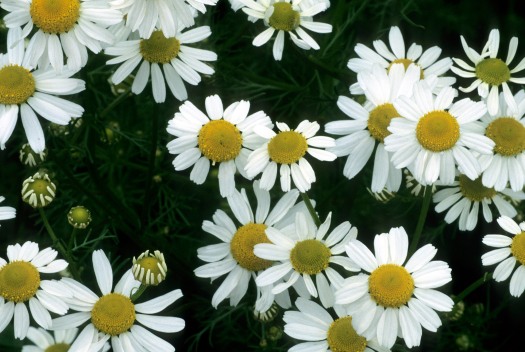
Photo via https://nccih.nih.gov
Love Lies Bleeding‘s readers know that main character Mara is both a vampire and a botanist. Trained when she was still human, she continues to study plants and have a garden. This post is seventh in a series exploring Mara’s plants. Are you interested in botany, gardening, or plant lore? So are some vampires…
Please note: Medicinal uses are given for informational purposes only. Always consult a medical professional before diagnosing or treating yourself or anyone else.
Botanical Name: Matricaria chamomilla (German chamomile) and Chamaemelum nobile (Roman or English chamomile).
Common Names: chamomile, camomile, German chamomile, Italian chamomile, Hungarian chamomile, wild chamomile, scented mayweed, Matricaria recutita, Roman chamomile, English chamomile, garden chamomile, Water of Youth, ground apple, mother’s daisy, whig plant, Anthemis nobilis, Anthemis, chamomilla, Flores Anthemidis, Grosse Kamille, Romische Kamile, manzanilla, sweet chamomile
History: Found near populated areas throughout temperate parts of the world, chamomile will grow in any disturbed soil, including along roadsides, near landfills, and in cultivated fields. It has been used medicinally since at least Ancient Egypt, and in beer making (and love potions!) since the Middle Ages. Roman chamomile was thought to be the superior form, hence the use of “nobile” (noble) in its botanical name, although research shows that German chamomile is actually the more potent of the two. Chamomile is the national flower of Russia.
Victorian Language of Flowers Meaning: Patience
Cultivation: Zones 3 to 9. German chamomile is an annual that readily self seeds. Roman chamomile is a perennial. Chamomiles like moist but well-drained soil and full sun (or part shade in hotter climates). Start seeds six weeks before last frost. Seeds need light to germinate, so scatter on top of potting mix, press firmly into the mix, and keep moist. Transplant outside after risk of frost has passed. (You can also directly sow seed outdoors in autumn.) Thin plants to 15 to 18 inches (38 to 45 cm) apart. Blooms June and July. After (Roman chamomile) plants flower, cut them back to soil level to ensure strong plants next season.
Uses:
Medicinal: Whichever type of chamomile you use, make a tea from the flowers and drink or apply externally, depending on what you’re treating. German chamomile in particular has been found to be antispasmodic and anti-inflammatory, making it ideal for menstrual and intestinal cramps, as well as coughs and colds. Chamomile is calming and has been traditionally used to help anxiety and insomnia. Cooled tea can be applied to skin to calm irritations and help with swelling (it can also be used as a mouth rinse for sores or inflammation). You can make a pot of strong tea and add it to bath water for a healing bath. Chamomile is a mild laxative, but has also been found to help treat diarrhea in children.
Caution: Chamomile can cause allergic reactions in anyone allergic to pollen or plants in the ragweed family. Chamomile may also negatively interact with other herbs and medicines. Avoid using if you’re taking anti-coagulants, NSAIDS, or sleep aids (including herbal kinds).
Caution 2: Pregnant and nursing women are advised to avoid using Roman chamomile. Infants should not be given chamomile, as (like honey) it may be contaminated with botulism spores, which a baby’s immature immune system can’t handle.
Cosmetics: Chamomile extract or essential oil can be added to skin creams as a soothing ingredient. Cooled chamomile tea can be used as a hair rinse to bring out blond highlights. Chamomile can also be added to homemade bath products, such as bath bombs.
Food: Home brewers can use the entire chamomile plant to add bitterness to beer. Chamomile flowers can be used in drinks (lemonade, smoothies, cocktails), in homemade popsicles, or in baking and other desserts. The flowers have a sweet apple or pineapple scent, and are worth experimenting with.
Crafts: Chamomile makes a nice addition to potpourri. You can also scent your home by gently simmering chamomile (fresh or dried leaves and/or flowers) in a pot of water on the stove (do not leave unattended; keep a close eye on water levels).
Gardening: Prevent damping off in seedlings by watering them with cooled chamomile tea. Planting chamomile near sick plants often results in healthier plants.
Mara’s Uses: Mara orders a cup of chamomile tea in Blood Magic (download your free copy here). Chamomile would also be included in remedies she sells via her apothecary business in Love Lies Bleeding, as well as the ones she used to help her fellow passengers in Tooth & Claw (download your free copy here).
Further Reading:

Love Lies Bleeding: Smashwords, Barnes & Noble, Kobo, Apple Books
FREE Blood Magic: Smashwords, Barnes & Noble, Kobo, Apple Books
FREE Tooth & Claw: Smashwords, Barnes & Noble, Kobo, Apple Books
If you prefer paperback, use this link to order Love Lies Bleeding from Bookshop – a portion of each sale goes directly to independent bookstores, as well as to myself. Thank you for supporting indie! ♥
What Are the Benefits of Chamomile Tea?
Cheers,
Aspasía S. Bissas
